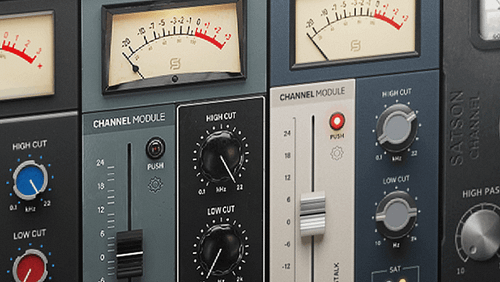When we talk about equalizers, most people think about filters and tone — tools for carving and sculpting the sound to clean any noise and enhance the quality of your recording.
What many users might not be aware of is that it’s all achieved by using delays. Not just any kind of delay — we are talking about frequency-dependent delays that cause a very particular effect called a phase shift.
How do equalizers work and how similar are these delays to the common effect that we use in our mixes? Let’s find out together.
EQ Basic Functioning
The first invented equalizers were analog electronic circuits. These pieces of gear use resistors, capacitors, and inductors to process the audio. The result is a very small delay at specific frequencies that we call phase shift. The equalizer combines the phase-shifted signal with the original signal, changing the frequency response of the audio by boosting or cutting those specific frequencies and creating the EQ curves that we are familiar with today.
The phase shift can produce artifacts in the audio. EQ designers try to minimize those artifacts, making them only audible in specific situations. This is why most equalizers are typically referred to as minimum phase equalizers.
The electronic design of the equalizer specifies at what frequency the phase shift occurs, while the knob controls the blend between the original and phase-shifted signal — very much like the feedback control on a tape recorder-based delay.
How Phase Shift Differs From Common Delay Effects?
While the phase shift is the result of different frequencies passing through filters at slightly different speeds, in a delay effect all the audio signal gets delayed and played back after a longer period of time, obtaining the characteristic echo-like effect.
Although phasing also occurs in time-dependent effects, like phasers or flangers, they still rely on recording the signal, playing it back, and blending it with the original as a regular delay. The difference in these kinds of effects is normally the shorter time delay and the modulation.
The Digital Era
When digital signal processing (DSP) became a reality, analog EQ turned into software, but the principles of their mechanics remained the same. The advantage was that the processing wasn’t limited by physical electronic components anymore. One could push the boundaries of audio processing and create EQ curves that would have been unthinkable in the analog domain.
One of the first applications of digital EQ was the creation of Linear Phase Equalisers. This type of equalizer eliminates the phase shift by simultaneously delaying the delayed and original signal, ensuring that the phase relationship of the sound remains intact and eliminating the artifacts caused by the phase shift.
Although this type of EQ sounds very appealing, it comes at a great cost in terms of processing, latency and they can also create their own artifacts like rings when processing transients.
The digital era has also allowed programmers to emulate the original analog EQ units by modeling their design with mathematical equations and creating plugins that sound almost indistinguishable from the physical gear.
Sonimus EQ collection
Sonimus has a diverse collection of EQs, characterized by their analog sound and unique modeling approach. Instead of just emulating specific equalizers, Sonimus gets the most beloved features of different devices and combines them in single plugins just like StonEQ 4k. They also push the boundaries in the market by creating new products like SonEQ 2, which following the heritage of the SonEQ family, it also brings modularity and oversampling capabilities to create your custom EQ with no compromises.
Did you know how equalizers work? Did you know about phase shift? What Sonimus EQ do you use in your mixes? Let us know in the comments, and subscribe to the newsletter to get notified about the latest blog articles.







Before I was a sound engineer I learned electronics. I studied circuits using transistors, resistors, capacitors , inductances, etc… When I became part of the recording world I could not help thinking about phase shifting when using an EQ !!!, it was painful for me to apply a lot of EQ just because I knew how much I was destroying the signal and the phase factor. Now I understand how beneficial a digital plug in could be if designed properly. I am glad to hear that Sonimus has been very meticulous designing EQ’s with with minimum phase shifting and oversampling to bring a peaceful mindset to people like me. Thanks for the article!. Luis.